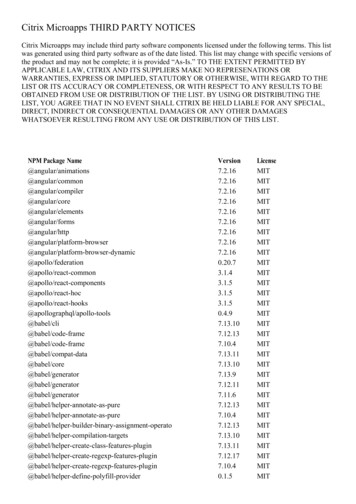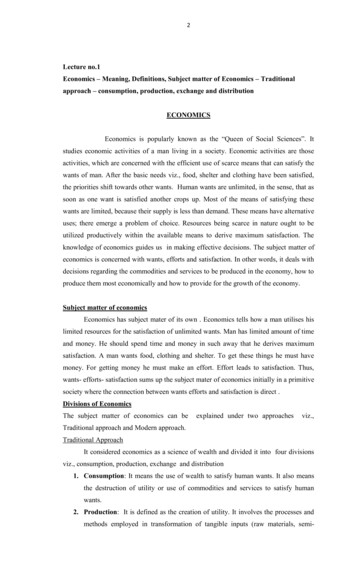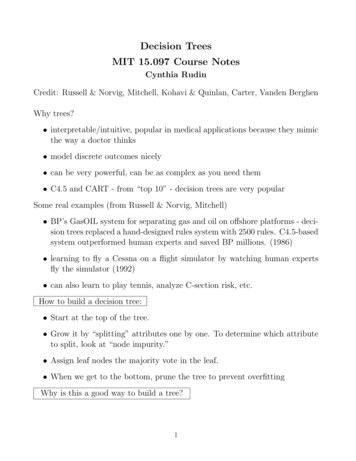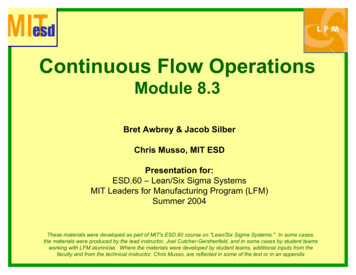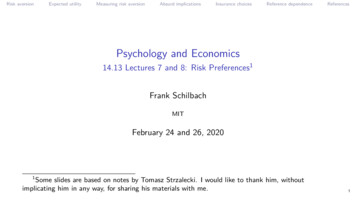
Transcription
Risk aversionExpected utilityMeasuring risk aversionAbsurd implicationsInsurance choicesReference dependenceReferencesPsychology and Economics14.13 Lectures 7 and 8: Risk Preferences1Frank SchilbachMITFebruary 24 and 26, 20201Some slides are based on notes by Tomasz Strzalecki. I would like to thank him, withoutimplicating him in any way, for sharing his materials with me.1
Risk aversionExpected utilityMeasuring risk aversionAbsurd implicationsInsurance choicesReference dependenceReferencesSome logistics Pset 2 will be posted later this week. Reminder: late submissions will NOT be accepted! Will post previous psets, midterms, and finals for you topractice Ask (and answer!) questions on the forum.2
Risk aversionExpected utilityMeasuring risk aversionAbsurd implicationsInsurance choicesReference dependenceReferencesPlan(1) Risk aversion(2) Expected utility(3) Absurd implications(4) Small vs. large-scale risk aversion3
Risk aversionExpected utilityMeasuring risk aversionAbsurd implicationsInsurance choicesReference dependenceReferencesWhat kinds of decisions involve risk/uncertainty? Many decisions involve options with varying amounts of risk and uncertainty Going to collegeHealth decisionsFinancial investmentsStudying for examsDatingRiding a bicycle. Some choices and decisions can reduce and mitigate risk Buying insuranceWearing a helmetAvoiding dangerous areas.4
Risk aversionExpected utilityMeasuring risk aversionAbsurd implicationsInsurance choicesReference dependenceReferencesRisk aversion What is risk aversion? Reluctance of a person to accept an option with an uncertain payorather thananother option with a more certain, possibly lower expected payo . Why are people risk-averse? Risk makes contingent planning harder.People are worried and stressed about risk und uncertainty.People feel regret over missed opportunities.People are disappointed if they don’t achieve expectations.Diminishing marginal utility of wealth.5
Risk aversionExpected utilityMeasuring risk aversionAbsurd implicationsInsurance choicesReference dependenceReferencesStylized fact 1: People are risk-averse. People buy insurance. Insurance industry exists to help people reduce (or diversify) risk. Social security Various other institutions Extended familiesSharecroppingInformal insurance.6
Risk aversionExpected utilityMeasuring risk aversionAbsurd implicationsInsurance choicesReference dependenceReferencesStylized fact 2: Risk reduction has its price. People are willing to take on risks if the return is high enough. Not everybody buys the safest car in the world. Restaurants face signifcant risk, yet people keep opening then. People put money into index funds or even riskier assets. One role of the fnance industry: risk intermediation O oad some risk from businesses to investors Investors accept some risk for a good return. People often face trade-o s between risk and (expected) reward7
Risk aversionExpected utilityMeasuring risk aversionAbsurd implicationsInsurance choicesReference dependenceReferencesStylized fact 3: People are also willing to take on some risks. People are not risk-averse in all situations. People play lotteries. Casino gambling Sports betting8
Risk aversionExpected utilityMeasuring risk aversionAbsurd implicationsInsurance choicesReference dependenceReferencesExpected monetary value (EMV) vs. expected utility (EU) Expected utility theory: Workhorse model for studying behavior under risk Helps us understand many important real-world economic choices Risk aversion is modeled via diminishing marginal utility Consider a gamble G over two states of the world. State 1 occurs with probability p and yields (monetary) payo x . State 2 occurs with probability 1 p and yields (monetary) payo y . What is the expected monetary value (EMV) of this gamble?PN EMV(p, x) i pi xi px (1 p)y A fair gamble is one with a price equal to its expected (monetary) value. What is the expected utility (EU) of this gamble?PN EU(p, x) i pi u(xi ) pu(x ) (1 p)u(y ) Evaluating gambles using EU gives the same answer as using EMV if u(·) is linear.9
Risk aversionExpected utilityMeasuring risk aversionAbsurd implicationsInsurance choicesReference dependenceReferencesExpected monetary value (EMV) and risk aversion EMV: frst model of how rational people should behave. U(G) EMV(G) is not descriptively accurate. People are risk-averse in most situations We now use EMV(G) to defne risk neutrality. A decision-maker is risk-neutral if, for any lottery G she is indi erent between Gand getting the EMV(G) for sure. The decision-maker is risk-neutral if u(·) is linear. Risk aversion A decision-maker is risk-averse if, for any lottery G, she prefers getting EMV(G) forsure, rather than taking G. A decision-maker is risk-loving if, for any lottery G, she prefers it to getting theEMV(G) for sure.10
Risk aversionExpected utilityMeasuring risk aversionAbsurd implicationsInsurance choicesReference dependenceReferencesExpected utility theory: example A person with wealth 10,000 is o ered a gamble: Gain 500 with 50% chance, lose 400 with 50% chance Will she accept the gamble? Expected monetary value (EMV): EMV(accept lottery) 0.5 · 9, 600 0.5 · 10, 500 10, 050 EMV(reject lottery) 10, 000 A risk-neutral decision-maker will accept the gamble (irrespective of initial wealth). Expected utility (EU): EU(accept lottery) 0.5 · u(9, 600) 0.5 · u(10, 500) EU(reject lottery) u(10, 000) Will an expected-utility maximizer accept the gamble? Depends on concavity of u(·)11
Risk aversionExpected utilityMeasuring risk aversionAbsurd implicationsInsurance choicesReference dependenceReferencesConcavity of u(·)ux u(·) is concave. For any x , y , and any p 2 (0, 1),u(px (1 p)y ) pu(x ) (1 p)u(y ). Implies u 00 (·) 0 if u(·) twice di erentiable.12
Risk aversionMeasuring risk aversionconcavityExpected utilityAbsurd implicationsInsurance choicesReference dependenceReferencesConcavity of u(·) x is associated with utility u(x ).y is associated with utility u(y ). px (1 p)y is a convex combination of xand y . u(px (1 p)y is the utility associatedwith this convex combination. u(·) is concave. For any x , y , and any p 2 (0, 1),u(px (1 p)y ) pu(x ) (1 p)u(y ). Implies u 00 (·) 0 if u(·) twice di erentiable. pu(x ) (1 p)u(y ) is the weighted averageof utilities associated with x and y . The utility of the average is higher than theaverage of the utilities.13
Risk aversionExpected utilityMeasuring risk aversionAbsurd implicationsInsurance choicesReference dependenceReferencesDo only fnal outcomes matter?Due to copyright restrictions, OCW cannot include the video"Why most people refuse to sell their lottery tickets for twice whatthey paid." Business Insider. You can view the video here.14
Risk aversionExpected utilityMeasuring risk aversionAbsurd implicationsInsurance choicesReference dependenceReferencesExpected utility theory: summary Many important economic choices involve risk. People are risk-averse in many contexts. Expected utility theory Main workhorse economic model for studying risk Weighted average of utilities from fnal outcomes matters. Risk aversion due to concavity of utility function15
Risk aversionExpected utilityMeasuring risk aversionAbsurd implicationsInsurance choicesReference dependenceReferencesHow do we measure risk aversion? Two main measures00(x ) Absolute risk aversion: r uu 0 (x) Why do we divide by u 0 (x )? What happens to r if we multiply u(x ) by a constant a? Relative risk aversion: 00 xuu0 (x(x)) x ·r0 is the elasticity of the slope of u(x ): @u@x(x ) u0x(x ) People with constant relative risk aversion invest a constant share of their wealth inrisky assets, regardless of their level of wealth.16
Risk aversionExpected utilityMeasuring risk aversionAbsurd implicationsInsurance choicesReference dependenceReferencesCommonly used utility functions in economics Constant absolute risk aversion (CARA)u(x ) e rxr00(x )where r is the coeÿcient of absolute risk aversion: r uu0 (x) Constant relative risk aversion (CRRA)u(x ) wherex 1 1 is the coeÿcient of relative risk aversion:00 xuu0 (x(x)) We will focus on CRRA functions, which are most commonly used in economics.17
Risk aversionExpected utilityMeasuring risk aversionAbsurd implicationsInsurance choicesReference dependenceReferencesHow can we estimate ? Suppose you have a CRRA utility function:x 1 1 for6 1,ln xfor 1(u(x ) Three approaches to estimate :(1) Certainty equivalents(2) Choices from gambles(3) Insurance choices18
Risk aversionExpected utilityEstimatingMeasuring risk aversionAbsurd implicationsInsurance choicesReference dependenceReferencesusing choices from using certainty equivalents Thought experiment Suppose your wealth equals either 50, 000 or 100, 000 each with probability 50%. Your expected wealth is [W ] 75, 000. What guaranteed amount (certainty equivalent) WCE do you fnd equally desirable?E Backing outfor di erent values of WCE :11u(WCE ) · u(50, 000) · u(100, 000)221 1 W1 50, 0001 100, 0001 ) CE · ·1 21 21 19
Risk aversionExpected utilityMeasuring risk aversionAbsurd implicationsInsurance choicesReference dependenceReferencesImplied values offor dierent values of WValue of γ1251030Value of WCE70,71166,66758,56653,99151,209 What kinds of insurance purchases do large values ofimply? If 30, you would probably not even leave your house! Economists often assume 2 (0, 2) in many applications, based on observedbehavior involving large-scale choices, e.g. Chetty (2006). Broader lesson: Choices involving large-scale risks suggest thatcan’t be ‘toolarge’.20
Risk aversionExpected utilityMeasuring risk aversionAbsurd implicationsInsurance choicesReference dependenceReferencesHow can we estimate ? Suppose you have a CRRA utility function:x 1 1 for6 1,ln xfor 1(u(x ) Three approaches to estimate :(1) Certainty equivalents(2) Choices from gambles(3) Insurance choices21
Risk aversionExpected utilityEstimatingMeasuring risk aversionAbsurd implicationsInsurance choicesReference dependenceReferencesusing choices from small-scale gambles Who would accept a 50-50 bet to win 11 vs. lose 10? What about a bet to win 110 vs. lose 100? If you turned down the bet, what can we learn about your ? What else do we need to know? Your utility function and your wealth level w . Suppose you have wealth of 20,000, and you turn down a 50-50 bet to win 110vs. lose 100. What can we learn about your ?11· u(20, 000 110) · u(20, 000 100)221 (20, 110)1 1 (19, 900)1 21 21 u(20, 000) )(20, 000)1 1 Can show that rejecting the bet implies 18.2. Implies ridiculous behavior for larger-scale gambles.22
Risk aversionExpected utilityMeasuring risk aversionAbsurd implicationsInsurance choicesReference dependenceReferencesRabin (2000): absurd implications Main line of argument People often turn down small-scale gambles with positive expected value. The expected utility model explains such behavior with curvature (concavity) of theutility function. Curvature over small stakes implies implausible risk aversion at large stakes. Reason: Marginal utility of money must decrease extremely rapidly. Argument requires no assumption about utility function except concavity Rabin and Thaler (2001) describe simplifed version of this reasoning.23
Risk aversionExpected utilityMeasuring risk aversionAbsurd implicationsInsurance choicesReference dependenceReferencesRabin (2000): example Johnny is a ‘risk-averse’ EU maximizer, i.e. assume u 00 (·) 0. He turns down a 50-50 gamble of losing 10 or gaining 11 for any level of wealth. What is the biggest Y such that we know Johnny will turn down a 50-50 lose 100/win Y bet?(a)(b)(c)(d)(e)(f)(g)(h)(i) 110 221 2, 000 20, 242 1.1 million 2.5 billionJohnny will reject the bet no matter what Y is.Johnny will reject the bet no matter what Y is. Whoa!!!We can’t say without knowing more about u(·).24
Risk aversionExpected utilityMeasuring risk aversionAbsurd implicationsInsurance choicesReference dependenceReferencesWhat is going on? Johnny’s choice implies:0.5u(w 11) 0.5u(w 10) u(w )) u(w 11) u(w ) u(w ) u(w 10) On average, Johnny values each dollar between w and w 11 by at most1011asmuch as the dollars between w 10 and w . Diminishing marginal utility (concavity) implies that the marginal dollar at w 10is at least as valuable as the marginal dollar at w . Similarly, the marginal dollar at w is at least as valuable as the marginal dollar atw 11 Taken together, this implies that Johnny values the dollar w 11 by at most1011as much as he values the dollar w 10.25
Risk aversionExpected utilityMeasuring risk aversionAbsurd implicationsInsurance choicesReference dependenceReferencesWhat is going on? (cont’d) Johnny makes the same choice when he is 21 richer:0.5u(w 21 11) 0.5u(w 21 10) u(w 21)) u(w 32) u(w 21) u(w 21) u(w 11) On average, he values each dollar between w 21 and w 32 by at most1011asmuch as the dollars between w 11 and w 21. Concavity implies that Johnny value the dollar w 32 by at most1011as much ashe values the dollar w 11.2 Hence he values the dollar w 32 by at most ( 1011 ) ˇ56as much as he values thedollar w 10.26
Risk aversionExpected utilityMeasuring risk aversionAbsurd implicationsInsurance choicesReference dependenceReferencesIterating this forward gives absurd implications! Rejecting the 50-50 lose 10/gain 11 gamble implies a 10 percent decline inmarginal utility for each 21 in additional lifetime wealth. 42 richer: (10/11)2 ˇ 5/6 420 richer: (10/11)20 ˇ 3/20 840 richer: (10/11)80 ˇ 2/100. Marginal utility plummets for substantial changes in lifetime wealth. You care less than 2% as about an additional dollar when you are 900 wealthierthan you are now.27
Risk aversionExpected utilityMeasuring risk aversionAbsurd implicationsInsurance choicesReference dependenceReferencesAbsurd implications! American Economic Association. All rights reserved. This content is excluded from our Creative Commons license. For moreinformation, see https://ocw.mit.edu/help/faq-fair-use/28
Risk aversionExpected utilityMeasuring risk aversionAbsurd implicationsInsurance choicesReference dependenceReferencesMeasuring risk aversion: preliminary summary Expected utility is the workhorse model for studying economic behavior under risk. Many important phenomena can be explained using this model. Example 1: investment behavior (fnance) Example 2: criminal behavior and risk of getting caught Coeÿcient of (relative) risk aversionis a key parameter of this model. Depending on the size of the gamble, we get very di erent answers for ! Small-scale gambles: people are very risk-averse. Large-scale risk: people are moderately risk-averse. The expected utility model can’t match both behaviors with only one parameter Rabin (2000) formalizes this issue. Recitation will discuss it a bit more.29
Risk aversionExpected utilityMeasuring risk aversionAbsurd implicationsInsurance choicesReference dependenceReferencesHow can we estimate ? Suppose you have a CRRA utility function:x 1 1 for6 1,ln xfor 1(u(x ) Three approaches to estimate :(1) Certainty equivalents(2) Choices from gambles(3) Insurance choices30
Risk aversionExpected utilityEstimatingMeasuring risk aversionAbsurd implicationsInsurance choicesReference dependenceReferencesusing insurance choices (Sydnor, 2010) Some doubts about validity of choices in lab games Would like to have real-world choices Sydnor (2010): data from large home insurance provider Random sample of 50,000 standard policies Policy parameters and claims fled over a one-year period Old and new customers What is a deductible? Expenses paid out of pocket before insurer pays any expenses Used to deter large number of claims31
American Economic Association. All rights reserved. This content is excluded from ourCreative Commons license. For more information, see https://ocw.mit.edu/help/faq-fair-use/Sample dataPolicyholder 1: Home was built in 1966 and had an insured value of 181,700.The menu available to this policyholder in the sample year was:Deductible 1,000 500 250 100Premium 504 588 661 773Relative to 1,000 policy0 84 157 269ChosenxPolicyholder 2: Home was built in 1992 and had an insured value of 266,100.The menu available to this policyholder in the sample year was:Deductible 1,000 500 250 100Premium 757 885 999 1,171Relative to 1,000 policy0 128 242 414ChosenxPolicyholder 2 had a higher premium for the 1,000 deductible contract thanPolicyholder 1, largely because Policyholder 2 had a higher insured home value.Policyholder 2, then, also faced a greater increase in cost for the alternative of a Choice over a menu of fourdeductibles 1, 000 500 250 100 Observe individuals’ choice setsand their preferred option32
Risk aversionExpected utilityMeasuring risk aversionAbsurd implicationsInsurance choicesReference dependenceReferencesChoosing a deductible What do these choices tell us about risk aversion? Losses to the customer are capped at the deductible. Choosing a lower deductible represents modest increase in insurance. Choice of low deductible thus reveals high risk aversion. What info do we need to learn about risk aversion? Available deductiblesPremium for each optionClaim probabilitiesWealth levels33
Risk aversionExpected utilityMeasuring risk aversionAbsurd implicationsInsurance choicesReference dependenceReferencesClaim rates are low: about 4 percent per yearTable 1—Summary StatisticsChosen deductibleVariableFullsample 1,000 500 250 ,679.50(4,584.58)709.78(269.34)1490.30Panel A. Selected policy variablesInsured home valueYear home was builtNumber of years insuredby the companyAverage age of household(H.H.) membersNumber of paid claims insample year (claim rate)Company payout per claimabove deductible levelYearly premium paidObservationsPercent of sampleNotes: Means with standard deviations are in parentheses. The average age measure was calculated by the insurancecompany based on information they have about household members. This variable is not used in rating. Insuredhome value is the coverage limit on the insurance policy. For the claim rate and payout by the company per claim,only claims that resulted in positive payouts by the company were counted. American Economic Association. All rights reserved. This content is excluded from our Creative Commons license. For more information, seehttps://ocw.mit.edu/help/faq-fair-use/34
Risk aversionExpected utilityMeasuring risk aversionAbsurd implicationsInsurance choicesReducing the deductible is expensive.Chosen deductibleAvailabledeductibleFullsample 1,000 500 250 100 615.82(292.59) 99.91(45.82) 86.59(39.71) 133.22(61.09) 798.63(405.78) 130.89(64.85) 113.44(56.20) 174.53(86.47) 615.78(262.78) 99.85(40.65) 86.54(35.23) 133.14(54.20) 528.26(214.40) 85.14(31.71) 73.79(27.48) 113.52(42.28) 467.38(191.51) 75.75(25.80) 65.65(22.36) 101.00(82.57)Reference dependenceReferences The average insurance pricewith a deductible of 1, 000is 615.82.Panel B. Deductible-premium menu 1,000 500 250 100 On average, reducing thedeductible from 1, 000 to 500 costs 99.91. On average, reducing thedeductible from 250 to 100 costs 133.22! American Economic Association. All rights reserved. This content is excluded from our Creative Commons license. For moreinformation, see https://ocw.mit.edu/help/faq-fair-use/35
Risk aversionExpected utilityMeasuring risk aversionAbsurd implicationsInsurance choicesReference dependenceReferencesPercent of customers holding each deductible levelYet the majority chooses small deductibles.90 1,00080 500 25070 10060504030201000–33–77–1111–1515 Number of years insured with companyFigure 1. Deductible Choice by Years Insured with Companynotes: This chart gives the fraction of customers holding each deductible level by groups of tenure with the company. The percent of the sample that falls into each category is as follows: 0–3 years (34.16 percent), 3–7 years(22.97 percent), 7–11 years (12.95 percent), 11–15 years (10.48 percent), 15 years (19.44 percent). American Economic Association. All rights reserved. This content is excluded from our Creative Commons license. For moreinformation, see https://ocw.mit.edu/help/faq-fair-use/36
Risk aversionExpected utilityMeasuring risk aversionAbsurd implicationsInsurance choicesReference dependenceReferencesChoosing a deductible Choice between one-year insurance contracts with yearly premium P anddeductible D Assumptions No other risk to lifetime wealth At most one loss during the year, with probability ˇ Accurate subjective beliefs about the likelihood of a loss Individuals maximize expected (indirect) utility-of-wealth function:V (w , P, D, ˇ) ˇ {z}prob(loss)· u(w P D) (1 ˇ) · u(w P) {zutility(loss)} {z } {z(1)}prob(no loss) utility(no loss)37
Risk aversionExpected utilityMeasuring risk aversionAbsurd implicationsInsurance choicesReference dependenceReferencesBacking out implied risk aversion from choices Choose contract j that maximizes expected (indirect) utility:max ˇ · u(w Pj Dj ) (1 ˇ) · u(w Pj ).j(2) Choices imply upper and lower bounds on risk aversion Upper bound for those who choose the 1,000 deductible Upper & lower bound for those who choose 500 or 250 deductible Lower bound for those who choose 100 deductible38
Risk aversionExpected utilityMeasuring risk aversionAbsurd implicationsInsurance choicesReference dependenceReferencesExample: Individual chooses 100 deductible The person prefers a 100 deductible over choosing a 250 deductible:V (w , P100 , 100, ˇ) ˇ ·(w P100 100)1 (w P100 )1 (1 ˇ) ·1 1 V (w , P250 , 250, ˇ) ˇ ·(w P250 250)1 (w P250 )1 (1 ˇ) ·1 1 Solving this equation yields lower bound for(for given P100 , P250 , w , and ˇ). Choosing a 100 deductible maximizes the available insurance. This choice reveals very high risk aversion in the expected utility framework. There are no options with even lower deductibles available, so we don’t know whatshe would have chosen for such deductibles.for this person. We thus don’t have an upper bound for39
Risk aversionExpected utilityImplied values of190Measuring risk aversionAbsurd implicationsInsurance choicesReference dependenceReferencesare enormous!American Economic Journal: applied economics october 2010Table 3—Bounds on Coefficient of Relative Risk AversionModel 1,000(n 2,474)LB UB 500(n 3,424)LB UB 250(n 367)LB UBReject any50/50 gamblewith potentialloss of 1,000Panel A. Bounds at the fiftieth percentile1 CRRA; 1 mil;deductible average2 CRRA; 1mil;individual estimate3 CRRA; 500k;individual estimate4 CRRA; IHV;individual estimate5 CRRA; 100k;individual estimate6 CRRA; 50k;individual estimate7 CRRA; 5k;individual estimate8 CARA; 1mil;individual estimateMode wealth 9832,0155,4114,62614,66199.9% 1,000(n 2,474)LB UB 500(n 3,424)LB UB 250(n 367)LB UBReject any50/50 gamblewith potentialloss of 1,000Panel B. Bounds at the twenty-fifth and seventy-fifth percentile1 CRRA; 1 mil;deductible average—3,1731,6145,5823,89815,283100.0% Table shows lower and upperbounds at the 50th percentile. Di erent rows show estimatesfor di erent assumption onutility function and wealth. Example: for w 50k andCRRA utility, almost allestimates yield 100! American Economic Association. All rights reserved.This content is excluded from our Creative Commonslicense. For more information, seehttps://ocw.mit.edu/help/faq-fair-use/40
Risk aversionExpected utilityMeasuring risk aversionAbsurd implicationsInsurance choicesReference dependenceReferencesWhy do people choose small deductibles? Neoclassical explanations Sydnor (2010) discusses several potential explanations in Section IV of the paper. High risk aversion: implies implausibly high values of (see above). High objective probability of claims: but actual claim rates are low (around 4%). Borrowing constraints: unlikely given that people have fairly expensive homes. None of these explanations plausibly explains the patterns in the data.41
Risk aversionExpected utilityMeasuring risk aversionAbsurd implicationsInsurance choicesReference dependenceReferencesWhy do people choose small deductibles? Behavioral explanations Sydnor (2010) also argues that several behavioral explanations are unlikely. Risk misperception: requires people to vastly overestimate risk, including many whohave been insured for over 15 years with this company. Marketing, social pressure: possible but company is not a low-cost provider, so salesagents often suggest high deductibles to lower policy costs. Menu e ects (people avoid extreme options): possible but does not explain whypeople choose 250 rather than 500 deductibles. Preferred explanation: reference-dependent preferences/loss aversion (next)42
Risk aversionExpected utilityMeasuring risk aversionAbsurd implicationsInsurance choicesReference dependenceReferencesSummary from risk preferences Choices involving small-scale and large-scale risks yield contradicting answers.(1) Individuals are risk-averse for small-scale risks. Such choices imply enormous risk aversion for large-scale risks. But individuals do not avoid large-scale risks at all costs.(2) Individuals are moderately risk-averse for large-scale risks. Such choices imply that individuals should be nearly risk-neutral for small-scale risks. But individuals exhibit risk aversion for small-scale risks! Kahneman and Tversky (1979) Even more evidence against the expected utility model Proposed alternative model, reference-dependent utility (loss aversion), canexplain individuals’ risk attitudes for both small-scale and large-scale risks.43
(iii) RiskMeasuringAversion:u is concave(u" 0). Insurance choicesrisk aversionAbsurd implicationsReference dependenceReferencesA person is risk averse if he prefers the certain prospect (x) to any risky prospectwith expectedx. In expected utility theory, risk aversion is equivalent to theKahneman andTverskyvalue(1979)concavity of the utility function. The prevalence of risk aversion is perhaps thebest known generalization regarding risky choices. It led the early decisiontheorists of the eighteenth century to propose that utility is a concave function of Surveymoney,responsesstudentsand universityfacultyand bythisIsraeliin modernidea hasbeen retainedtreatments (Pratt [33], Arrow[4]). ‘Essentially identical’ results in Stockholm and MichiganIn the following sections we demonstrate several phenomena which violatethese tenets of expected utility theory. The demonstrations are based on the Series of hypothetical, large-stake choices such as this one:responses of students and university faculty to hypothetical choice problems. Therespondents were presented with problems of the type illustrated below.Which of the following would you prefer?Risk aversionExpected utilityA:50% chance to win 1,000,B: 450 for sure.50% chance to win nothing;The outcomes refer to Israeli currency. To appreciate the significance of theamounts involved, note that the median net monthly income for a family is about3,000 Israeli pounds. The respondents were asked to imagine that they wereactually faced with the choice described in the problem, and to indicate the44
268Risk aversionExpected utilityAND A. TVERSKYD. KAHNEMANMeasuring risk aversionAbsurd implicationsInsurance choicesReference dependenceReferencesThe Reflection EffectGains and lossesThe previous section discussed preferences betweenpositive prospects, i.e.,prospects that involve no losses. What happens when the signs of the outcomes are heircolumn ofTableIThe fnalleft-handlosses?are replacedreversedso thatgains peopledisplaysfour of the choice problems that were discussed in the previous section,associatedprobabilities).and the right-hand column displays choice problems in which the signs of the KahnemanandareTverskystrikingevidencethis predictionWe use -xto denotereversed.(1979):the loss contradictingof x, and to denotetheoutcomesprevalent preference, i.e., the choice made by the majority of subjects.TABLE IPREFERENCES BETWEEN POSITIVE AND NEGATIVE PROSPECTSPositive prospectsProblem 3:N 95Problem 4:N 95Problem 7:N 66Problem 8:N 66Negative prospects(4,000, .80) (3,000).[20][80]*(4,000, .20) (3,000, .25).[35][65]*(3,000, .90) (6,000, .45).[86]*[14](3,000, .002) (6,000, .001).[27][73]*Problem 3':N 95Problem 4':N 95Problem 7':N 66Problem 8':N 66(-3,000).(-4,000, .80) [8][92]*(-4,000, .20) (-3,000, .25).[58][42](-3,000, .90) (-6,000, .45).[8][92]*(-3,000, .002) (-6,000, .001).[70]*[30]In each of the four problems in Table I the preference between negative The EconometricSociety. Allrightsreserved.Thisis excludedbetweenfrom ourpositiveCreative prospects.Commons license.ofcontentThus, For morethe preferenceprospectsis themirrorimageinformation, see https://ocw.mit.edu/help/faq-fair-use/th
Psychology and Economics . 14.13 Lectures 7 and 8: Risk Preferences. 1. Frank Schilbach . MIT. February 24 and 26, 2020 . 1. Some slides are based on notes by Tomasz Strzalecki. I would like to thank him, without implicating him in any way, for sharing his materials with me. 1

